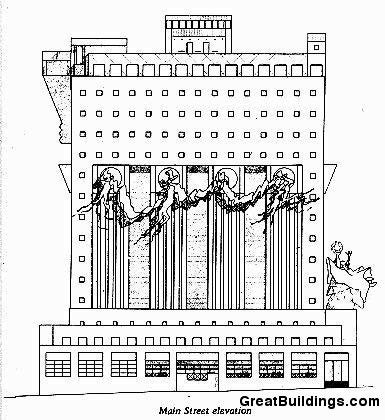Alessi teapots, Target clocks, Disney Dolphin Hotels, and the Washington Monument restoration—Michael Graves has influenced a generation of American design with a breadth few architects in history have matched. But it was the cream, salmon-, and blue-colored Portland Building, published on a 1982 cover of Time magazine, that first introduced Graves and the architectural movement of Postmodernism to the wider world.
 Arguably Portland’s most demonstrative contribution to architectural history, the Portland Building also has been an equally notorious problem: long-loathed by city employees who work inside and plagued with structural problems and leaks. The City of Portland is pondering the landmark’s future. Who better to ask what should happen than its designer?
Arguably Portland’s most demonstrative contribution to architectural history, the Portland Building also has been an equally notorious problem: long-loathed by city employees who work inside and plagued with structural problems and leaks. The City of Portland is pondering the landmark’s future. Who better to ask what should happen than its designer?
The University of Oregon’s John Yeon Center and the Portland Art Museum are pleased to present “Michael Graves Live” at 7 p.m. Thursday, October 9, at the museum’s Fields Ballroom. Tickets to the event may be purchased online.
In a live, on-stage chat with journalist and Yeon Center director Randy Gragg, Graves will explore two topics: 1) his career’s evolution since the Portland Building, and, in particular, since an infection rendered him a paraplegic in 2003 inspiring a turn to designing everything from wheelchairs to housing for disabled veterans; and 2) what of the Portland Building should be preserved and what might change during its upcoming renovation.
Completed in 1981, the Portland Building became an instant icon of the Postmodernist break from the cookie-cutter corporate modernism that had come to dominate architecture, particularly in public buildings. It was listed on the National Register of Historic Places in 2012. Built for less than a common commercial office building of the era, the cut-rate budget led to dreary interiors and devastating leaks. After considering several options for the Portland Building—among them demolishing it—the City of Portland will soon solicit proposals from developers, architects, and contractors for a remodel.
Few architects might understand the need for adaption better than Graves, now 80, winner of the Presidential Medal of the Arts in 1999 and the American Institute of Architects Gold Medal in 2001. Ignoring what he thought to be a minor sinus problem in 2003, he woke up to find himself paralyzed from the chest down by an infection that had invaded his brain and spine. But soon after, Graves turned to designing different tools and surroundings for those living with disabilities, from the Prime TC, a replacement for the traditional hospital wheelchair, to the “Michael Graves Active Living Collection,” which includes showerheads, collapsible canes, walkers, and bath seats.

Above: The Portland Building, designed by Michael Graves. Photo courtesy www.greatbuildings.com.

Above: Elevation drawing of the Portland Building. Photo courtesy www.greatbuildings.com.
